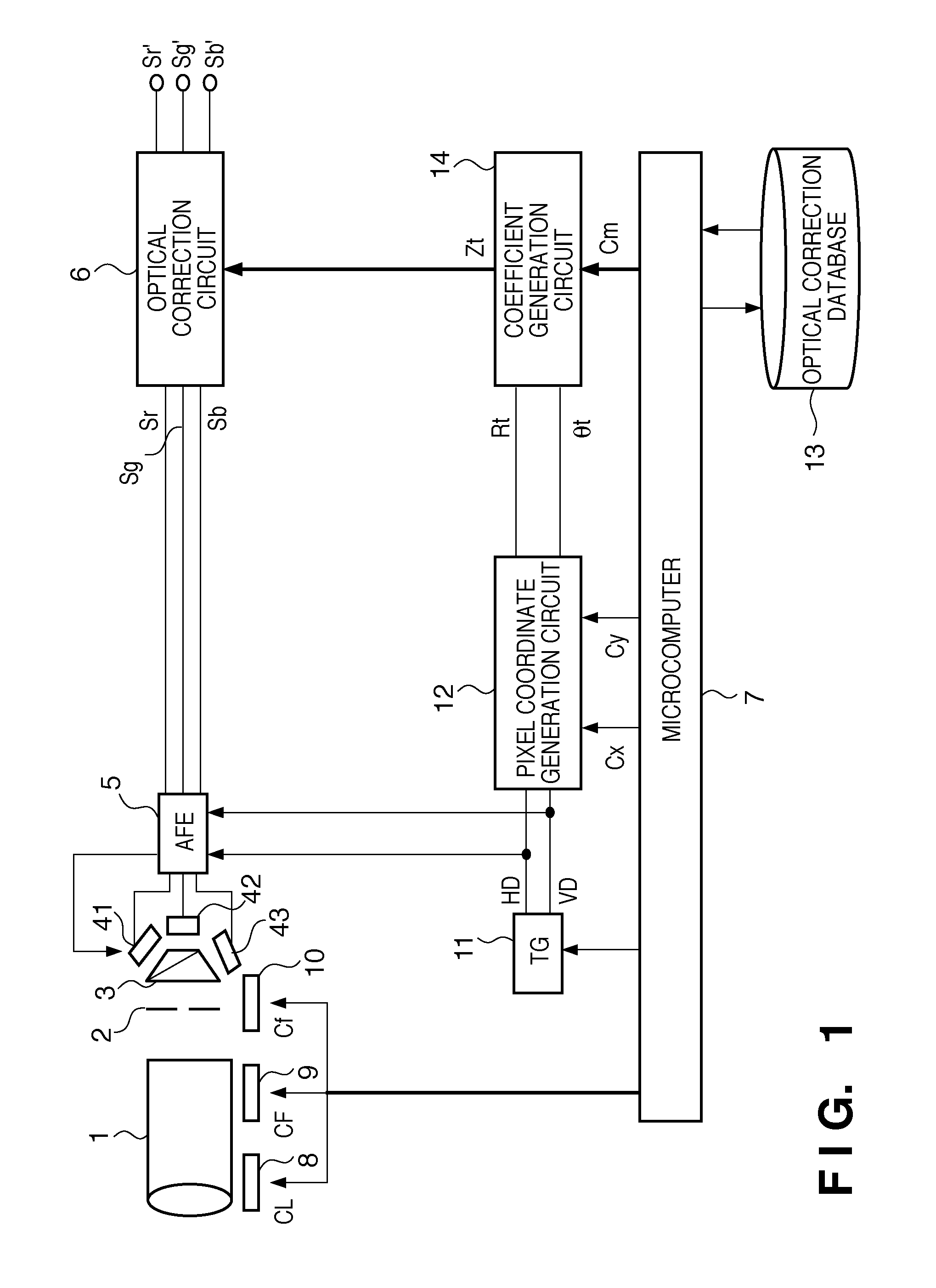Image sensing apparatus and image data correction method
a technology of image sensing apparatus and image data, which is applied in the direction of instruments, television systems, optical elements, etc., can solve the problems of deterioration of image quality that is principally caused by optical systems, chromatic aberration reduction, and reduction of the quantity of light in the periphery, so as to quickly correct the deterioration of image quality and expand the configuration of the apparatus.
- Summary
- Abstract
- Description
- Claims
- Application Information
AI Technical Summary
Benefits of technology
Problems solved by technology
Method used
Image
Examples
embodiment 1
[0037]FIG. 1 is a block diagram showing a schematic configuration of an image sensing apparatus according to Embodiment 1. In FIG. 1, reference numeral 1 denotes a lens unit that includes a zoom lens and a focus lens, and 2 denotes a diaphragm. In the case where the image sensing apparatus is a video camera, an optical system including the lens unit 1 and the diaphragm 2 is controlled according to various factors such as zooming operation, object motion, object change, change in the ambient brightness of the environment, and photographic effects intended by the photographer. In other words, optical parameters, typical examples of which include focal length, focus position and aperture value, are constantly controlled and vary.
[0038]Light that has passed through the optical system including the lens unit 1 and the diaphragm 2 is color-separated by a color separating prism 3 into red (R), green (G) and blue (B), which are then respectively formed on image sensors 41 to 43 as optical i...
embodiment 2
[0088]Embodiment 1 given above described the case of correcting a decrease in the quantity of ambient light as optical characteristics. In Embodiment 2, a case of correcting a magnification chromatic aberration or distortion aberration will be described. The overall configuration of the apparatus is the same as that shown in FIG. 1, and thus a description thereof is omitted here.
[0089]Magnification chromatic aberration correction and distortion aberration correction are processes for repositioning a pixel to a pixel position (coordinates) at which obtained image data at the pixel is to be positioned in the absence of a magnification chromatic aberration or distortion aberration, and not processes for correcting image data itself. Accordingly, in Embodiment 2, the direction and distance of movement of a pixel (coordinates) are stored as correction amount plot data.
[0090]Here, the correction coefficient Zt is the amount of offset in which the amount of offset of the pixel position is ...
embodiment 3
[0101]Next, Embodiment 3 of the present invention will be described. FIG. 14 is a block diagram showing a schematic configuration of an image sensing apparatus according to Embodiment 3. The same components as those of the image sensing apparatus of FIG. 1 are given the same reference numerals, and descriptions thereof are omitted here. The difference from Embodiment 1 of the present invention is that a feature detection circuit 15 that detects features of captured images is disposed prior to the optical correction circuit 6, and that the microcomputer 7 acquires a feature evaluation value Id (feature amount).
[0102]The feature detection circuit 15 carries out at least one of contrast detection, high frequency component detection and motion detection on the digital image signals Sr, Sg and Sb, and outputs a feature evaluation value Id.
[0103]In the case of contrast detection, the feature detection circuit 15 is configured as shown in FIG. 15A, for example. The digital image signals Sr...
PUM
 Login to View More
Login to View More Abstract
Description
Claims
Application Information
 Login to View More
Login to View More - R&D
- Intellectual Property
- Life Sciences
- Materials
- Tech Scout
- Unparalleled Data Quality
- Higher Quality Content
- 60% Fewer Hallucinations
Browse by: Latest US Patents, China's latest patents, Technical Efficacy Thesaurus, Application Domain, Technology Topic, Popular Technical Reports.
© 2025 PatSnap. All rights reserved.Legal|Privacy policy|Modern Slavery Act Transparency Statement|Sitemap|About US| Contact US: help@patsnap.com



